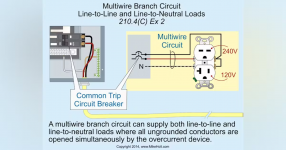dm9289
Industrial Maintenance Electrician
- Location
- Pennsylvania
- Occupation
- Industrial process repair/ maintenance Electrician
A Electrician friend asked me about an installation and to me it did not seem correct but thru Nec I could not find a reference.
From the basement a double pull 20 amp 120/240 GFCI breaker feeds a Disconnect switch in a pool area. From this disconnect a 240V pool pump is direct wired and 1 leg of the 240v is used to direct feed the 120 volt electronics of a gas pool heater. For some reason this bothers me, is this code compliant?
Another odd tidbit when the person fires up their 120 volt air compressor on a separate circuit the double pull GFCI trips now that he got a new inverter driven pool pump?
From the basement a double pull 20 amp 120/240 GFCI breaker feeds a Disconnect switch in a pool area. From this disconnect a 240V pool pump is direct wired and 1 leg of the 240v is used to direct feed the 120 volt electronics of a gas pool heater. For some reason this bothers me, is this code compliant?
Another odd tidbit when the person fires up their 120 volt air compressor on a separate circuit the double pull GFCI trips now that he got a new inverter driven pool pump?


